Fig. 10.1
Materials needed for venipuncture: vacutainer, vacutainer adapter, butterfly needle, tourniquet, gauze, alcohol swab, BAND-AID®, and properly fitting gloves
The Tourniquet
Accidents Happen When
The tourniquet is tied before preparing and assembling all equipment. Delay in preparation will result in patient discomfort and loss of confidence in the provider.
Solution
Gather and assemble all equipment first. Tying the tourniquet is the last step before the actual venipuncture.
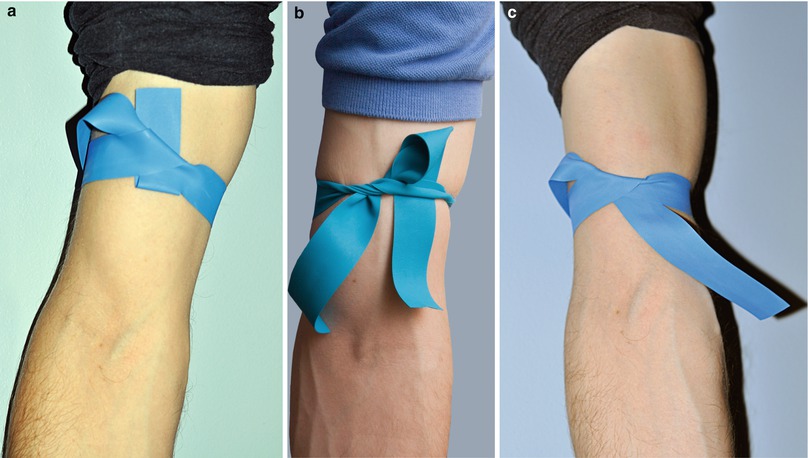
Fig. 10.2
Three ways tourniquets are commonly tied incorrectly: (a) Too loose, causing inadequate insufflation of the vein, resulting in a failed stick. (b) Ends point into the field, obscuring vision and interfering with venipuncture. (c) No slip-knot, requiring two hands for removal. The needle would need to be withdrawn before removing the tourniquet, predisposing to excess bleeding and eye splash
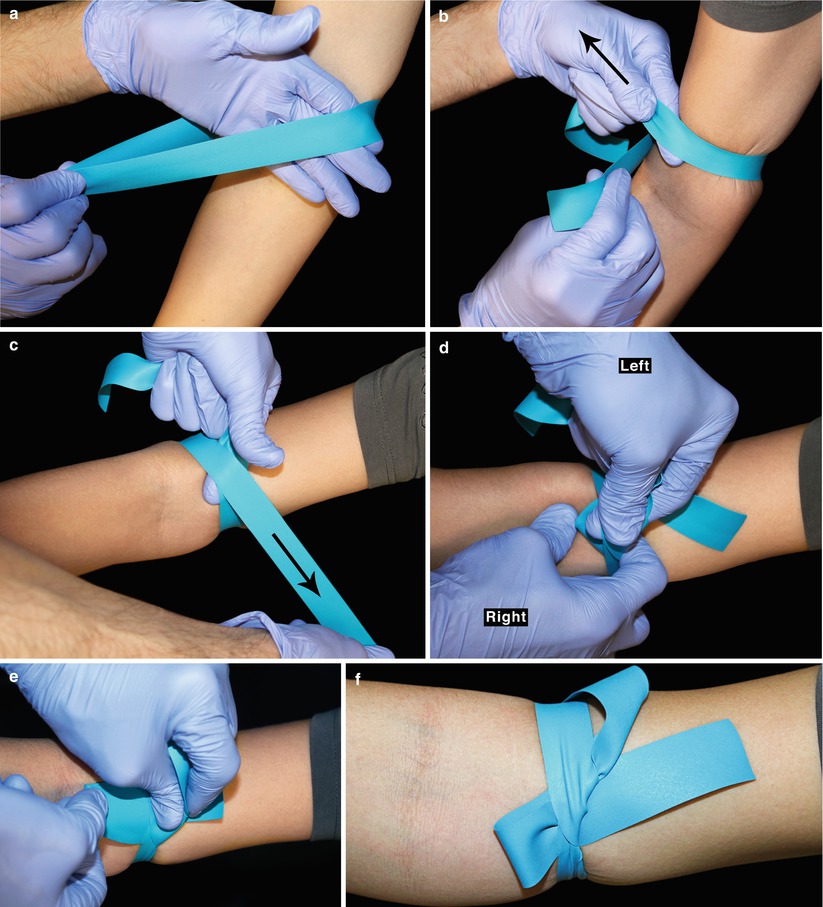
Fig. 10.3
Tying a tourniquet. (a) Grasp ends without tension. Place hand at medial arm. (b) Pull medial tail taught, stopping at the top of the bicep. (c) Pull lateral tail taught crossing at the top of the bicep and pinch secure with thumb. (d) Lift (with left index finger) and tuck under (with right index finger). (e) Release the left index finger by holding traction on the tucked loop. (f) Final placement with appropriate tension, ends pointing away from the field, and a slip knot
Solution 2
Use a clip-on tourniquet that can be released with one hand (Fig. 10.4). One drawback of the clip-on tourniquet is that it is reusable and can become contaminated with blood. Practice unclipping it prior to using it during a live blood draw.
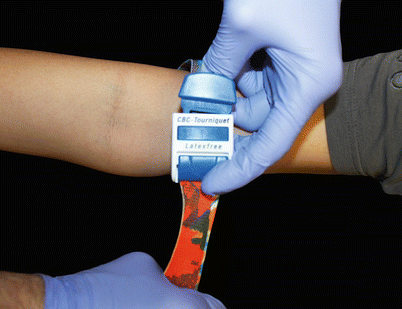
Fig. 10.4
Clip-on tourniquet
Accidents Happen When
Tying the tourniquet without confidence, causing the patient to doubt your skills.
Solution
The more efficient you are, the more the patient will be at ease.
Accidents Happen When
The needle is withdrawn before releasing the tourniquet. Eye splash and excessive bleeding can result from pressurized blood.
Solution
Always remove the tourniquet before withdrawing the needle.
Accidents Happen When
The tourniquet is left on too long. While ischemia should not be an issue for a few minutes, leaving the tourniquet tied longer than one minute can falsely elevate potassium readings [1].
Solution 1
After 2 min, consider undoing the tourniquet for a moment and retying if venipuncture is not successful.
Solution 2
Always remove a tourniquet before leaving a patient (e.g., to get something or answer a message), especially in the in-patient setting.
Needle Safety Mechanisms
Accidents Happen When
Activation of a safety mechanism for a needle is not understood prior to its use.
Solution 1
Become familiar with the safety mechanism of needles using clean devices (Fig. 10.5). “Wasting” one or two devices eliminates surprises and prevents injury. Safety mechanisms may not be intuitive, and different types of needles may have different methods of safety mechanism activation.
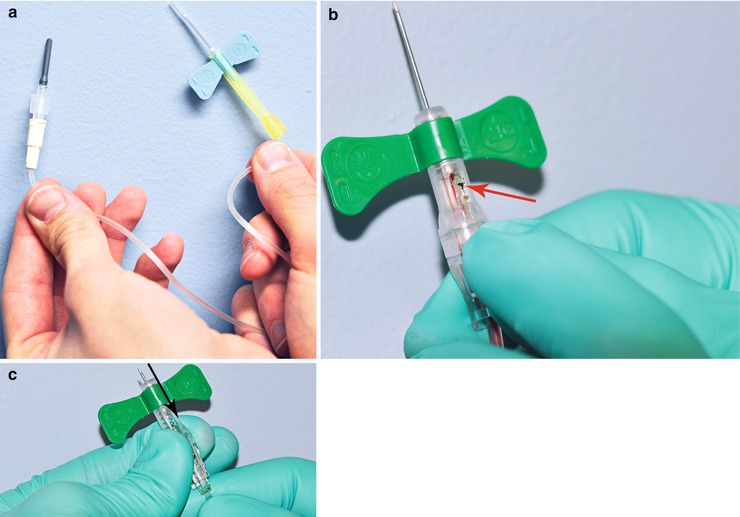
Fig. 10.5
Needle safety devices. (a) Sheath device. (b) Button-retraction device . The red arrow indicates the button that activates spring-loaded retraction. (c) Button-retraction device activated
Solution 2
Do not struggle with the activation mechanism if you are not familiar with it. In this scenario, immediately dispose of the needle in the sharps container after its use (Fig. 10.6).
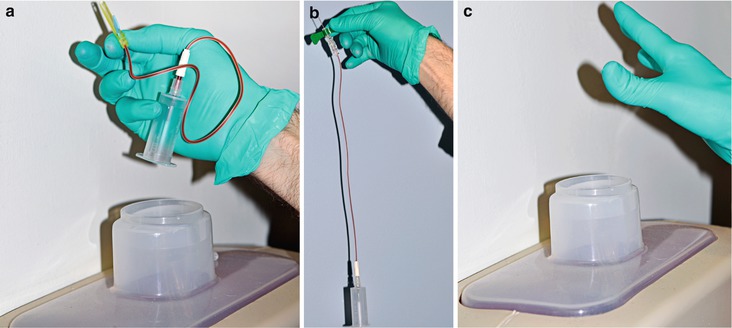
Fig. 10.6
Disposing of a live needle. (a) The thumb/index maintains position. (b) Let the vacutainer/butterfly complex hang down into the bin. Ensure the needle points away from the fingers. (c) Slowly let go. Make sure the wing does not stick to your gloved finger from too much pressure
Accidents Happen When
The wing is held so firmly in the thumb/index that it does not release when over the sharps container (Fig. 10.7).
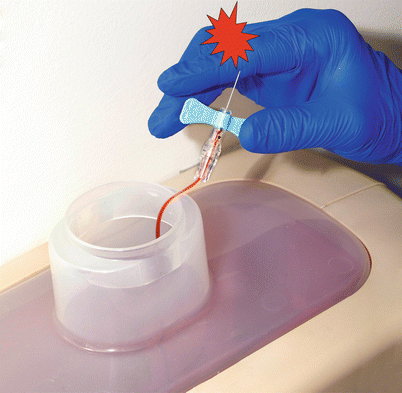
Fig. 10.7
A tight grip on the wing makes it “stick” to the fingers. Rapidly withdrawing the hand before the wing drops causes the needle to hitchhike and may result in a stick
Solution
Release the grip on the wing without withdrawing the hand (avoid abrupt motions). Be sure the needle has left the fingers before withdrawing the hand.
The Venipuncture
Accidents Happen When
A patient faints during the phlebotomy.
Solution
For all patients, engage in active, two-sided conversation (e.g., “What are you doing this afternoon?” or “Where did you go for vacation?”). Lie patients down who exhibit pallor, diaphoresis, or nausea.
Accidents Happen When
The needle is uncapped with two hands pulling in opposite directions (Fig. 4.1).
Solution 1
Some caps are “screw-offs” rather than “pull-offs”. Identify the mechanism to avoid forcibly pulling a screw mechanism.
Solution 2
For “pull-offs,” stabilize the hands (Fig. 10.8). If the cap does not come off readily, ask for help or discard the needle and try with another one.
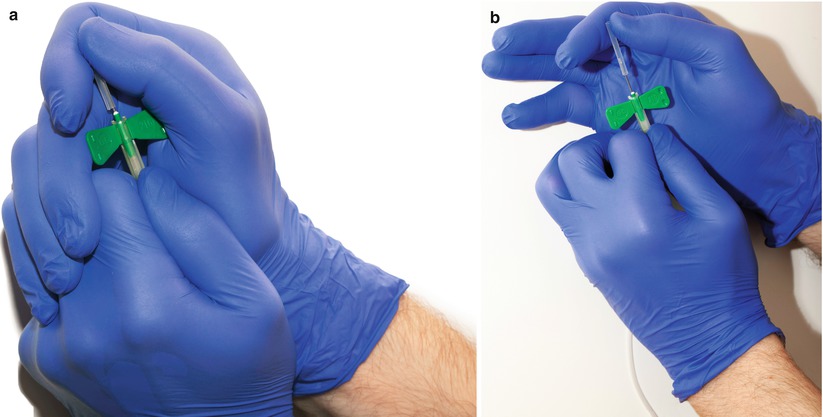
Fig. 10.8
Opening “pull-off” cap of a butterfly needle. (a) Free cap with wrist extension. Anchoring fingers restrict cap displacement. (b) Uncap needle without force by separating hands
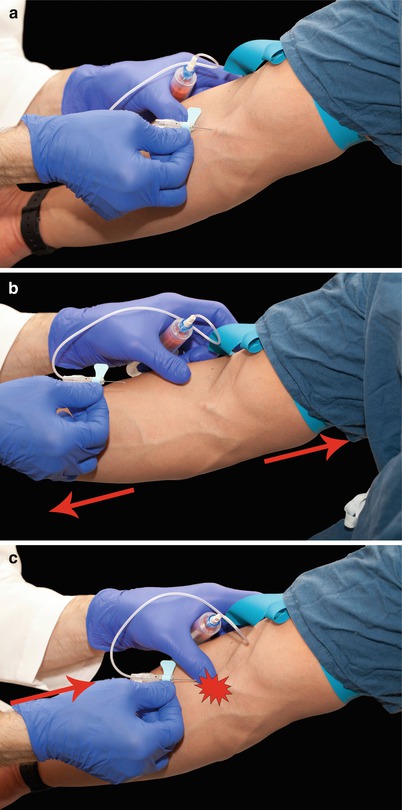
Fig. 10.9
Needle stick from patient flinch. (a) Needle contacts patient’s skin. (b) Patient withdraws (right red arrow) at initial venipuncture. Practitioner withdraws (left red arrow) as a startle response. (c) Rebound from the instinctual attempt to regain needle placement after the flinch (red arrow) can result in a needle stick
Stay updated, free articles. Join our Telegram channel

Full access? Get Clinical Tree








